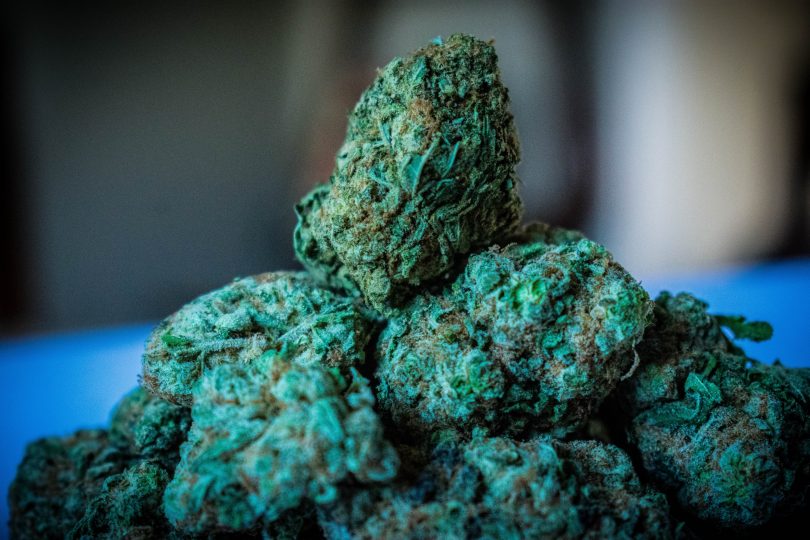There are some fundamentals for cannabis storage: control for temperature and humidity, don’t let it oxidize in open air, and keep it away from light. In poor storage conditions, cannabis decomposes quickly. With this in mind, researchers recently decided to find “optimal postharvest storage conditions for [c]annabis products intended for patients or research.” [1]
The study explains that past research on the subject is limited in several important ways. For one, the methods used may have affected the cannabinoids and terpenes; for example, gas chromatography analysis with high temperatures can decarboxylate samples. Also, the number of compounds analyzed was fairly limited—tetrahydrocannabinol (THC) and degradation product cannabinol (CBN) are typical.
In this 2020 study, researchers chose Lemon Kush, a THC-rich chemovar, and Golan, a CBD-rich chemovar. They kept samples in the dark but explored different temperatures, namely -80º, -30º, 4º and 25º C, as well as two flower conditions, whole or ground (with a coffee grinder). On top of the flower conditions, ethanol extracts were dissolved in olive oil, ethanol, or dimethyl sulfoxide as storage solvents.
Different analytical techniques were performed at fixed intervals during the course of one year:
- At baseline and every 4 months, to measure cannabidiol (CBD), THC, and CBN: Reversed phase ultra-high performance liquid chromatography with ultraviolent detection (UHPLC/UV)
- At baseline and month 12, to measure other phytocannabinoids: Electrospray ionization with liquid chromatography/mass spectrometry (ESI-LC/MS)
- At baseline and month 4, to measure the terpenoids of Golan: Static headspace (SHS) with gas chromatography and tandem mass spectrometry (GC-MS/MS)
- At baseline and every 6 months, to measure the phytocannabinoids of the extracts: UHPLC/UV and ESI-LC/MS
Terpenoids were only analyzed for the ethanol storage solvent. The researchers noted “matrix compound overlaps” for the other storage conditions (olive oil and dimethyl sulfoxide) using SHS-GC-MS/MS. In other words, those solvents interfered with the analysis.
Not surprisingly, the room temperature condition of 25º C showed the most dramatic overall effects on flowers and extracts. THC and CBD reached their highest levels by month 12 at this temperature having decarboxylated from their acidic forms. Tetrahydrocannabinolic acid (THCA) from Lemon Kush dropped by approximately 33%.
Degradation products from all cannabinoids increased most significantly at 25º C, including CBN and “additional unidentified phytocannabinoids.” That said, CBN remained low (<0.01% w/w) in the CBD-rich chemovar. It is thus not relevant as an age marker in hemp over these timeframes.
By month 4, flower illustrated a significant spike (from baseline) in THC, CBD, and CBN across temperature conditions. Beyond this, ground cannabis resisted significant changes across time at -80º C, -40º C, and 4º C. Whole cannabis continued to demonstrate significant changes at these temperatures. The authors explain that the greater surface area of ground cannabis gives it a higher initial rate of decomposition.
This was the case with terpenes, where ground cannabis samples had lower baseline terpene concentrations. Terpenes declined on average across all temperatures and conditions from baseline to month 4 by about 50%. Initial extraction also decimated baseline terpene levels of extracts.
Interestingly, the lowest storage temperature of -80º C caused the greatest loss of terpenes (especially monoterpenes like α-pinene) after 4 months. The temperature of -30º C was also detrimental. The authors note that “it is very difficult to preserve the original terpenoid contents in inflorescences, and this must be accounted for when reporting the terpenoid concentrations of a specific chemovar.” For terpenes, they recommend not grinding cannabis or storing it below -20º C. On the other hand, lower temperatures were superior for preserving phytocannabinoids.
Olive oil proved the best preservative for extracted phytocannabinoids at all temperatures and time points. It was protective even at 25º C. Nonetheless, whole flowers were more stable than extracts.
Overall, “slow decarboxylation occurs over long storage periods, even at very low temperatures.” [1] The authors recommend 4º C for terpenes and phytocannabinoids. As cannabis medicine and research continue to flourish, optimal storage conditions can be pinpointed to avoid unstable and unreliable product.
Reference
- Milay L, Berman P, Shapira A, Guberman O, Meiri D. Metabolic profiling of cannabis secondary metabolites for evaluation of optimal postharvest storage conditions. Frontiers in Plant Science. 2020;11(583605). [Impact Factor: 4.407; Times Cited: 1 (Semantic Scholar)]
Image by John Miller from Pixabay








